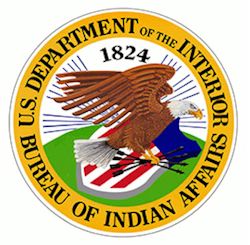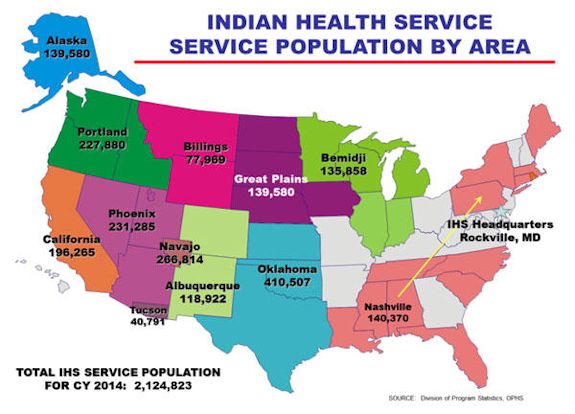Many Native Americans who live on reservations must deal with the federal government through two agencies: the Bureau of Indian Affairs and the Indian Health Service.
Bureau of Indian Affairs (BIA)
 The Bureau of Indian Affairs (BIA) is an agency of the federal government of the United States within the US Department of the Interior charged with the administration and management of 55.7 million acres (87,000 sq. miles or 225,000 km²) of land held in trust by the United States for Native Americans in the United States, Native American Tribes and Alaska Natives.
The Bureau of Indian Affairs (BIA) is an agency of the federal government of the United States within the US Department of the Interior charged with the administration and management of 55.7 million acres (87,000 sq. miles or 225,000 km²) of land held in trust by the United States for Native Americans in the United States, Native American Tribes and Alaska Natives.
The Bureau of Indian Affairs is one of two Bureaus under the jurisdiction of the Assistant Secretary – Indian Affairs: the Bureau of Indian Affairs and The Bureau of Indian Education, which provides education services to approximately 48,000 Native Americans.
The BIA’s responsibilities once included providing health care services to American Indians and Alaska Natives. In 1954, that function was legislatively transferred to the U.S. Department of Health, Education and Welfare, now known as the Department of Health and Human Services, where it has remained to this day as the Indian Health Service (IHS).
The BIA carries out its core mission to serve 564 Federally recognized tribes through four offices:
- The Office of Indian Services – operates the BIA’s general assistance, disaster relief, Indian child welfare, tribal government, Indian Self-Determination, and Indian Reservation Roads Program.
- The Office of Justice Services – directly operates or funds law enforcement, tribal courts, and detention facilities on Federal Indian lands. OJS funded 208 law enforcement agencies consisting of 43 BIA operated Police and 165 tribally operated under contract, or compact for operation with the OJS. The office has seven areas of activity: Criminal Investigations and Police Services, Detention/Corrections, Inspection/Internal Affairs, Tribal Law Enforcement and Special Initiatives, the Indian Police Academy, Tribal Justice Support, and Program Management. The OJS also provides oversight and technical assistance to tribal law enforcement programs when and where requested. Operates four divisions: Corrections, Drug Enforcement, Indian Police Academy, Law Enforcement.
- The Office of Trust Services – works with tribes and individual American Indians and Alaska Natives in the management of their trust lands, assets, and resources.
- The Office of Field Operations – oversees 12 regional offices; Alaska, Great Plains, NorthWest, Southern Plains, Eastern, Navajo, Pacific, Southwest, Eastern Oklahoma, Midwest, Rocky Mountain, and Western, and 83 agencies which carry out the mission of the Bureau at the tribal level.
Indian Health Services (IHS)

Indian Health Service (IHS) is an Operating Division (OPDIV) within the U.S. Department of Health and Human Services (HHS). IHS is responsible for providing medical and public health services to members of federally recognized Tribes and Alaska Natives. IHS is the principal federal health care provider and health advocate for Indian people, and its goal is to raise their health status to the highest possible level.
IHS provides health care to American Indians and Alaska Natives at 33 hospitals, 59 health centers, and 50 health stations. Thirty-four urban Indian health projects supplement these facilities with a variety of health and referral services.
The provision of health services to members of federally recognized tribes grew out of the special government-to-government relationship between the federal government and Indian tribes.
This relationship, established in 1787, is based on Article I, Section 8 of the Constitution, and has been given form and substance by numerous treaties, laws, Supreme Court decisions, and Executive Orders. The IHS currently provides health services to approximately 1.8 million of the 3.3 million American Indians and Alaska Natives who belong to more than 557 federally recognized tribes in 35 states.
IHS was established in 1954 to take over health care of American Indians and Alaska Natives from the Bureau of Indian Affairs. All federally recognized Native American and Alaska Natives are entitled to health care. This health care is provided by Indian Health Service, either through IHS-run hospitals and clinics, or through tribal contracts to provide health care services.
IHS-run hospitals and clinics serve any registered Indian/Alaska Native, regardless of tribe or income. Tribal contract health care facilities serve only their tribal members, with other qualified Indians/Alaska Natives being offered care on a space available basis.
This policy makes it difficult or impossible for an Indian who leaves their tribal home for education or employment to receive the health care services to which they are legally entitled.
An IHS fact sheet clarifies that Indians are also eligible to apply for any low income health care coverage provided by state and local governments, such as Medicaid.
In fact, IHS 2007 Third-Party Collections were FY $767 million, and estimated to be $780 million in 2008. Most Tribally-Operated Health Care services clinics require Native Americans who would qualify for Medicaid to apply and use their benefits at their clinics, supplementing the block grant funds they received from IHS to serve their tribe’s medical needs.
This double-dipping can create profits in some federally funded tribally-operated health clinics, while providing desparately needed services to tribes that are under-funded by IHS.
The Indian Health Service suffers from inadequate funding and is unable to adequately serve the population it is trying to serve in most instances.
Some of those who are served by this system are not satisfied with the efficiency of IHS. Others have concerns that restrictions of the Indian preference policy do not allow for the hiring of the most highly qualified health professionals and administration staff, so quality of care and efficiency of administration suffer.
The 2010 United States federal budget includes over $4 billion for the IHS to support and expand the provision of health care services and public health programs for American indians and Alaska Natives (AI/ANs).
Investments in the Indian health care system will focus on improving the health outcomes of American Indians and Alaskan Natives, and promoting healthy Indian communities.
The Budget builds upon resources provided in the recovery Act for IHS. This covers 2.5 million Native Americans and Alaskan Natives for an average cost per person of $1,600, far less than the average cost of health care for other United States Citizens.